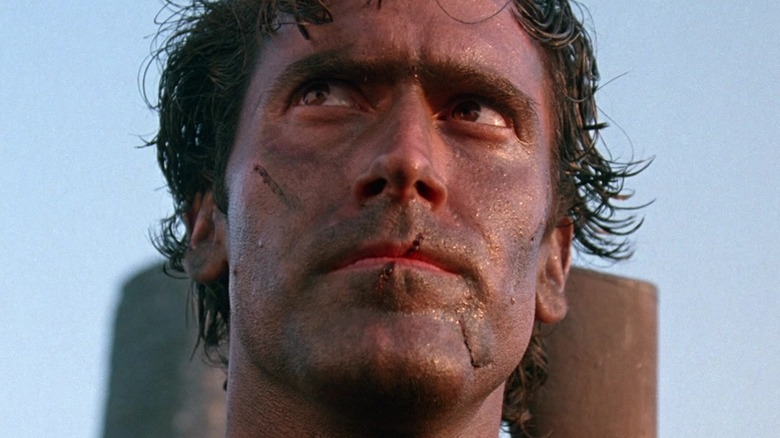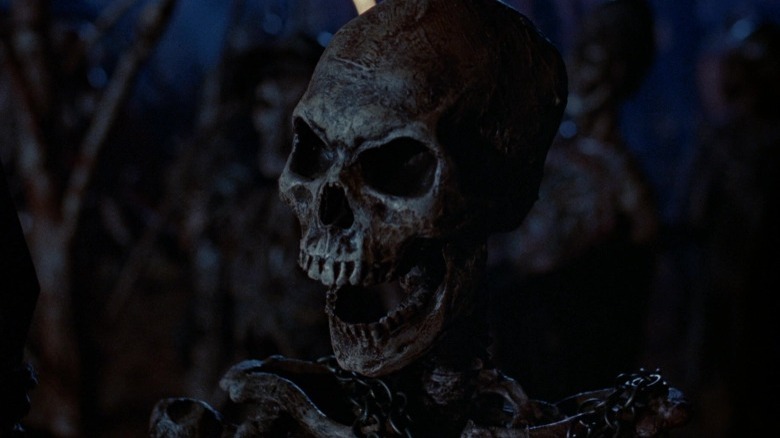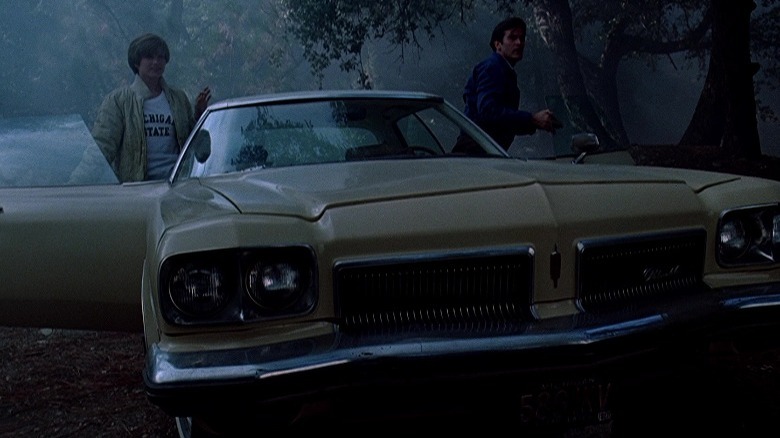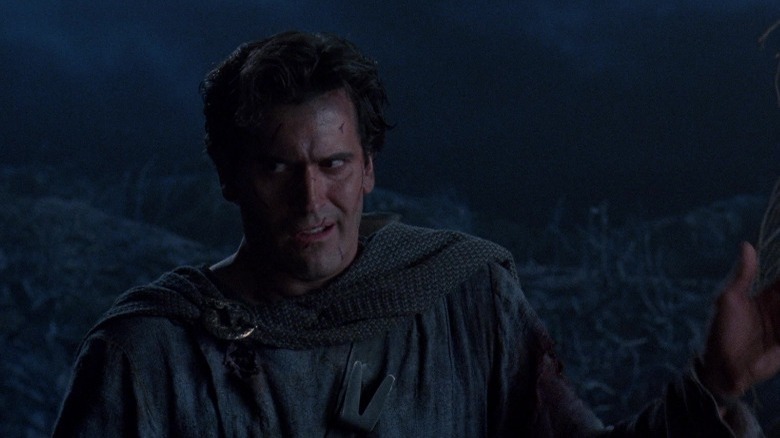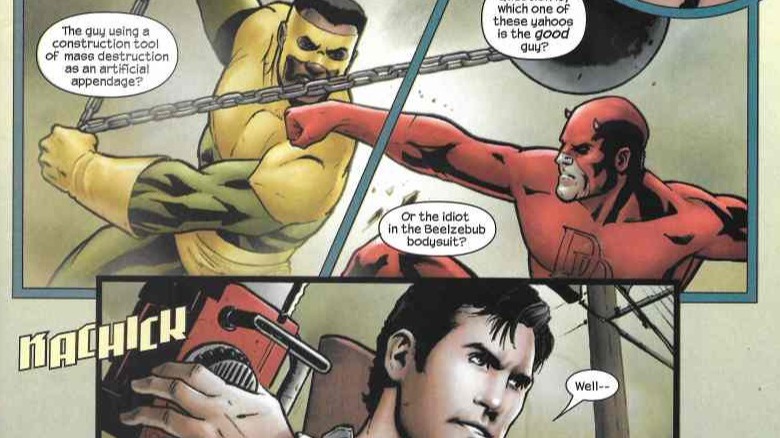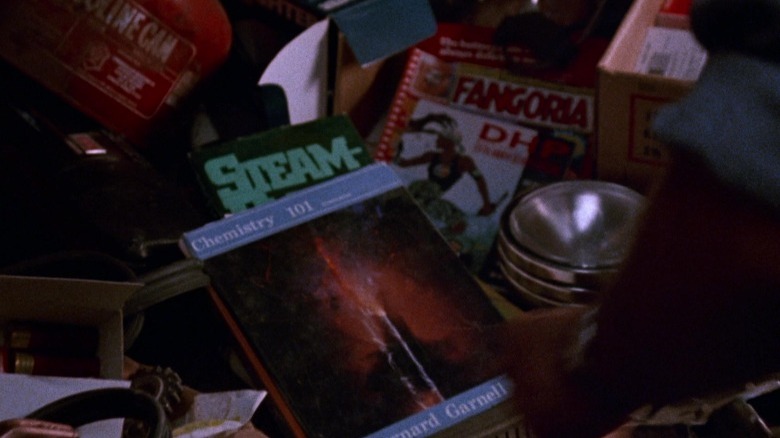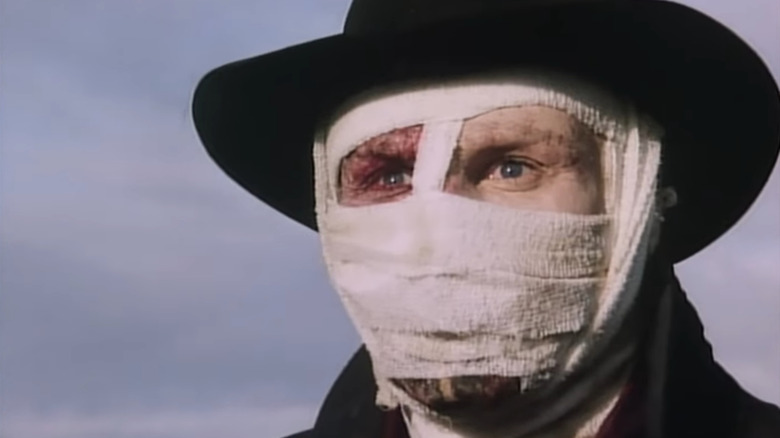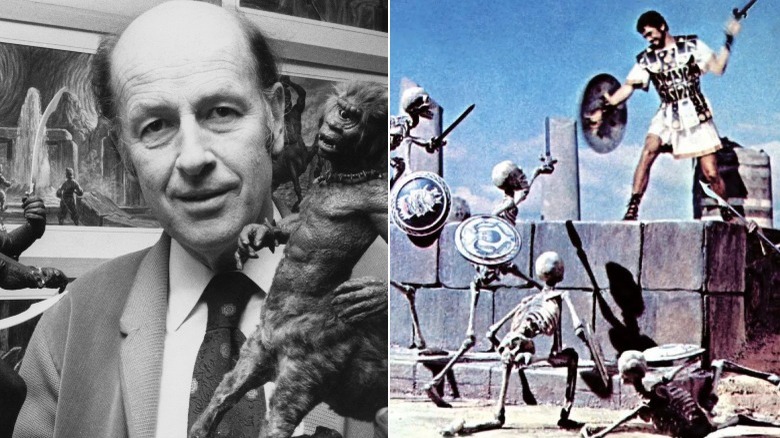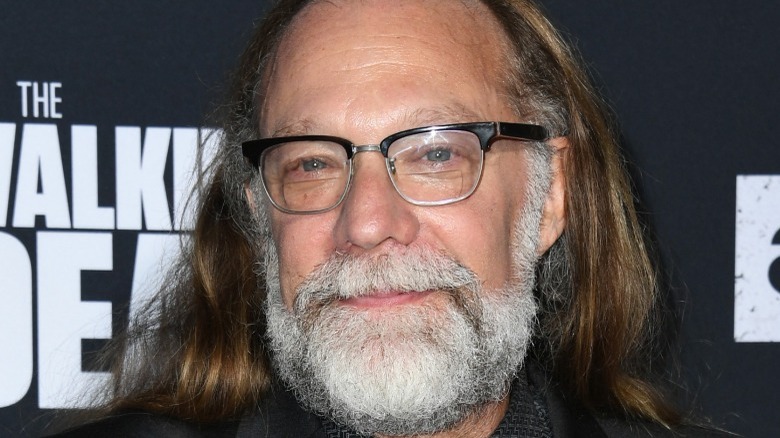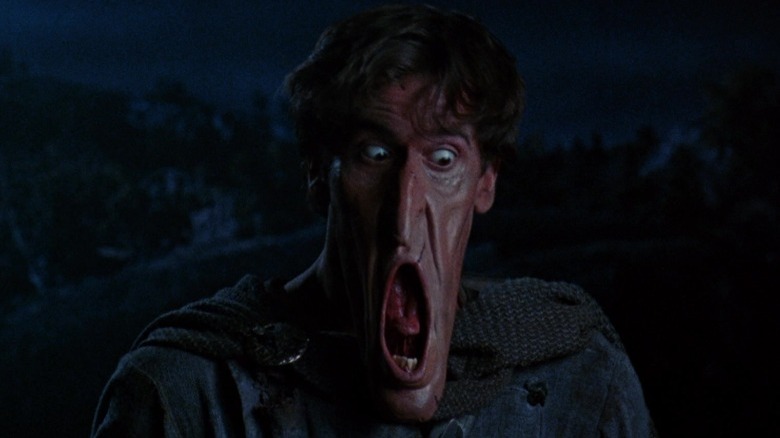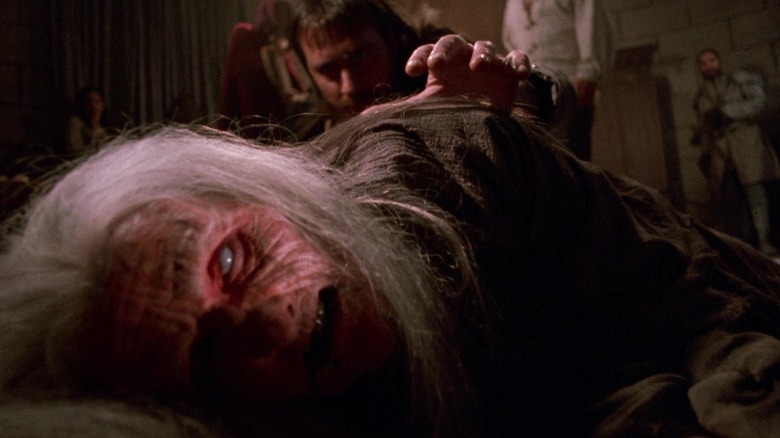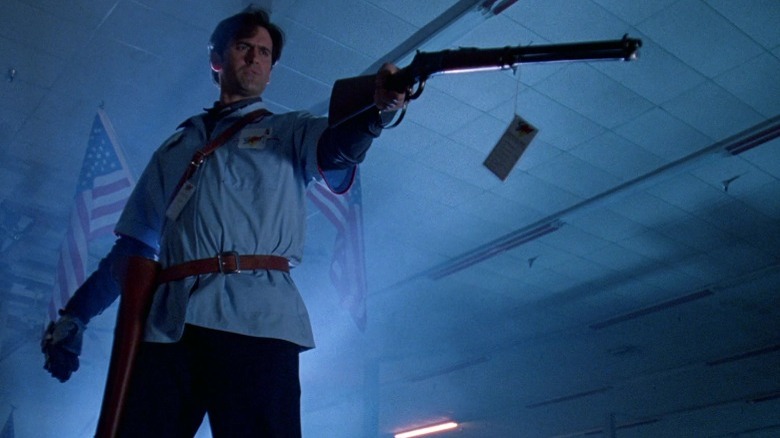The Untold Truth Of Army Of Darkness
All right, you primitive screw-heads, listen up! There's a new sheriff in town, and his name is Ash Williams (Bruce Campbell). In 1992, "Army of Darkness" burst onto the scene, overjoying fans of director Sam Raimi's "Evil Dead" series with a brand-new look at Ash's battle with evil. This time, the fight travels to the Middle Ages. Ash doesn't have time for the petty squabbles of kings and men during this age. He just wants to kill evil and return home. With his boomstick and well-worn chainsaw, it's time for all common folk to hail to the true king ... uh, baby.
Despite being the third in a trilogy for the horror-comedy series, the film's a bit of a black sheep. The film expands greatly on the "Evil Dead" mythology, adding a new layer to the Deadites with entirely different designs to the monstrosities. Furthermore, the film abandons the isolation of the Tennessee cabin for an open rural landscape set during medieval times. Instead of being scared of the Kandarian demons, Ash is mostly now irritated that they're ruining his life. It's the temperament he needs to pull off the mixture of badassery and slapstick comedy that follows. Raimi's "Evil Dead" franchise has long maintained a loyal fan base, with "Army of Darkness" becoming the oddest — and most supremely quotable — entry in the series. In honor of humankind's savior, Ash Williams, let's dive into some of the lesser-known aspects of the film. Buckle up, boneheads, 'cause you're goin' for a ride!
The film's title wasn't Sam Raimi's original choice
The title "Army of Darkness" caused plenty of confusion among fans and viewers. It is most certainly "Evil Dead 3," even if it isn't named as such. However, the distributor, Universal Pictures, was not the one that had handled the other two films in the series and wanted to separate this film from its predecessors (per Bloody Disgusting). It's easy to imagine how brand confusion could occur, given that the words "evil" and "dead" were nowhere to be seen in the title.
"Army of Darkness" was never Sam Raimi's first choice for the film. Of course, the director wanted to connect his horror trilogy. However, Raimi had a clever title planned for the film — "The Medieval Dead." The pun fits right into the film's unusual world of horror-comedy. Ultimately, the studio nixed the idea in favor of a standalone title that'd set this film apart from the first two.
Among the film's cameos are Bridget Fonda and the Stay Puft Marshmallow Man
The "Evil Dead" films made a big splash despite their indie roots. Horror master Stephen King gave the original film plenty of street cred thanks to a rave review in Twilight Zone Magazine (per Bloody Disgusting). When it came time to work on the third installment, Sam Raimi had managed to snag a few major connections, including a distributing partner in Universal Pictures.
Among these connections is puppet modeler and special effects actor Billy Bryan, who did effects work on the film and plays the Deadite in the pit. He's most well-known for being the Stay Puft Marshmallow Man in "Ghostbusters." Actor Ted Raimi, brother of director Sam Raimi, also makes a handful of appearances in the film as at least four characters, including two villagers and a dying soldier (spotlighted in a making-of doc). He shows his face once again in the final moments of the film as an S-Mart employee. Maybe that employee is the descendant of a certain medieval soldier, eh?
Another significant cameo in the film is actress Bridget Fonda, portraying Ash's girlfriend, Linda, in the introductory sequence. Younger audiences may not be familiar with Fonda, but the actress had appeared in several 1980s and '90s films, including "Doc Hollywood," "Single White Female," and "Lake Placid." Bruce Campbell revealed in "Medieval Times — The Making of Army of Darkness" that she was a fan of "Evil Dead" and simply wanted to play a small role somewhere in the threequel film. The rest is history.
The phrase to retrieve the Necronomicon is pulled from a classic sci fi film
At a pivotal moment in the film, Ash is instructed to obtain the Necronomicon. In doing so, the wise man councils Ash that he must repeat three words precisely before taking the book. Forgoing this step would bring about dire consequences. Of course, Ash forgets the final word and attempts to trick the powers that be by mumbling through it. That doesn't work out so well. The words that he should have recited are "Klaatu barada nikto." Though necktie, nectar, or nickel — words he initially brainstormed in his forgetful stupor — were probably much closer to fooling the Deadites than his fake coughing act.
However, ardent sci-fi fans might recognize the phrase. "Klaatu barada nikto" is a phrase that can be heard in the 1951 film "The Day the Earth Stood Still." An alien by the name of Klaatu advises the protagonist of the film to recite the phrase to a robot named Gort if, for some reason, Klaatu is killed. It's a failsafe that causes the robot to retrieve and restore Klaatu. Other films such as "Return of the Jedi" have also paid homage to sci-fi history by referencing the phrase. In that "Star Wars" film, Jabba has two aliens in his palace that he employs. They are named "Klaatu" and "Barada." Klaatu belongs to a race of aliens known as the Green Nikto. "Army of Darkness" pays tribute to the film more openly with the phrase's recitation as a pivotal moment in the narrative. Klaatu probably never expected his phrase to hold the power of repressing evil.
In a comic book spin-off to Army of Darkness, Ash takes on zombified Marvel heroes
Ash's adventure to the Middle Ages is just a singular thread in a wide web of tales — at least if you take the world of comic books into account. Of course, fans can find a comic book adaptation of the film's story published by Dark Horse comics. Another miniseries of comics envisions a continuation of the film where the wise man finds Ash to tell him he was wrongly sent to the moment before he went to the cabin. This sets up an all-new clash with Evil Ash.
The comic book storylines didn't stop there. Ash Williams enjoyed several crossovers with entirely different properties. In "Army of Darkness vs. Re-Animator," Ash comes face-to-face with Dr. Herbert West of "Re-Animator" fame. Ash would even tangle with another Sam Raimi creation in comic books, Darkman. As far as horror-centric properties go, Ash enters the world of Freddy Krueger and Jason Voorhees in multiple limited series. There's even a five-issue crossover with Marvel titled "Marvel Zombies vs. The Army of Darkness." In the alternate universe where many of the most famous Marvel heroes are zombies, Ash has the pleasure of meeting the vilest versions of these beloved characters. The crossovers involving the "Army of Darkness" brand don't stop there. Ash also shares comics with Xena, Vampirella, and the villain from another Bruce Campbell film: "Bubba Ho-Tep." "Army of Darkness" kicked off plenty of stories in the comic book world.
A comic book and a certain famous horror film magazine can be seen in Ash's trunk
"Army of Darkness" might enjoy several laughs, but it's still a fixture of the horror genre much like its predecessors. After all, Ash's greatest nemesis is the masses of possessed undead at the hands of demonic forces. Regardless of humor, that concept is pretty terrifying. Of course, Ash shows that his horror cred exceeds the bounds of his conflict with the evil dead with a peculiar magazine in his trunk. "Fangoria," a long-running and famous horror magazine, can be seen sitting among the seemingly random elements of Ash's trunk as he searches for items that will aid in the fight against the Deadites.
Of course, as we've already covered, "Army of Darkness" made a splash in the comic book medium following the release of the film. Many of those comics were published by Dark Horse Comics. Also, in the trunk of the Delta an issue of "Dark Horse Presents: Fifth Anniversary Special" can be seen. This massive collection of one-shot stories released in April 1991 includes series Dark Horse is known for like "Aliens vs Predator" and Frank Miller's "Sin City." Miller even drew the cover image of the book. In the scene, the comic is laying on top of the "Fangoria" issue. Sam Raimi is a comic book fan — which isn't surprising given his mid-career output.
The success of Darkman made Army of Darkness possible
While the first two "Evil Dead" films received a massive cult following in the years to come, they weren't exactly box office smashes upon their debut. In all fairness, they were high-effort, low-budget indie horror films that weren't meant to be blockbusters and didn't need much to recuperate those budgets anyway. In 1990, Sam Raimi partnered with a major studio (Universal) for the Liam Neeson-led "Darkman." The film's titular character is the eventual persona of Dr. Peyton Westlake, a man who is physically maimed and nearly killed by mobsters. He creates face masks using his new synthetic skin that he had developed to infiltrate and take revenge on the mobsters for what they had done.
On a budget of just over $8 million, "Darkman" raked in a decent profit with over $48 million in worldwide revenue. According to Bruce Campbell, this success convinced Universal to partner with producer Dino De Laurentiis for the third installment of the "Evil Dead" saga. It seems fitting that Ash Williams and Darkman would meet in the comic book world since their fates are intrinsically tied to one another from a commercial perspective.
The skeleton Deadites were an homage to visual effects artist Ray Harryhausen
"Army of Darkness" took a much different approach to the Deadites than in previous films. Specifically, much of the Deadite army is populated with reanimated evil skeletons. Much of the special effects work is done with stop-motion animation and tangible practical effects. In the advanced age of cinema that we live in, CGI is typically the go-to for special effects in cinema. But the animated skeletons from "Army of Darkness" hail from a far different era in filmmaking.
If you're a film connoisseur, you might be thinking to yourself that this imagery looks rather familiar. That's because it should. Sam Raimi intentionally wanted to pay tribute to special effects wizard and pioneer Ray Harryhausen. Bruce Campbell explained in "Medieval Times — The Making of Army of Darkness" that the animated skeletons were a direct homage to the living skeletons depicted in 1963's "Jason and the Argonauts." The film is an epic retelling of the Greek myth involving Jason and the Golden Fleece. The scene where Harryhausen brought to life seven skeletons in a climactic battle is often a point of reference for succeeding experts in the field. It was considered an incredible feat for the time and is seen as one of Harryhausen's greatest masterworks.
Greg Nicotero of The Walking Dead fame worked on the special effects
There were many hands involved in bringing the army of Deadites to life in this "Evil Dead" entry. After all, the film adopted a larger scale than its predecessors. One of the biggest names in the industry as far as special effects are concerned is Greg Nicotero. He began his professional career working side-by-side with Tom Savini and George Romero on the 1985 zombie-fest "Day of the Dead." Nicotero has gone on to work on countless films in the realm of make-up and special effects, including "From Dusk Till Dawn," "Scream," "Sin City," "The Grey," "Suicide Squad," and "Once Upon a Time... in Hollywood."
Perhaps his biggest claim to fame is leading the special effects for (and directing many episodes of) the ultra-popular and long-running AMC series "The Walking Dead." All that time spent under Savini's mentorship for "Day of the Dead" really paid off. Nicotero even dons the bloody and gory meat suit himself in several episodes as a zombie, wearing his own prosthetics and make-up. In Hollywood, Nicotero is among the best of the best in the industry, and he can lay claim to a piece of "Evil Dead" history with his work on "Army of Darkness."
Bruce took a beating during filming
Despite what anyone might think, acting can be physically demanding work. For low-budget films like the "Evil Dead" franchise, Bruce Campbell had to do all of the gross-out, bloody action and slapstick moments. He had to be covered in countless buckets of fake blood and dirt. You can imagine the showers that'd be required from a heavy day of shooting.
Campbell even discussed at length how he had to learn how to ride horseback. He shared that it was a good thing he wore a cape so viewers couldn't see his rear smacking the saddle with each gallop. On set, he and other producers on the show claimed that Sam Raimi jokingly "had it out for him."
While the actor and director are close friends, Raimi got a kick out of torturing Bruce, and many of the hijinks Ash goes through on-screen were concocted by Raimi. Filming in the hot desert of Southern California only added to the exhaustive efforts of everyone involved. Between wearing countless facial and body prosthetics, being covered in dirt, learning choreography for fight sequences, and taking hits from running into mirrors or being tossed down a hill, Campbell jokingly said he became cynical toward other actors. Humorously, in the "Making of" documentary, he said, "It's probably, I would say, the most physically uncomfortable movie in the history of motion pictures, and I'm just going to say that." The making of "Army of Darkness" was grueling.
The original witch scene was much longer
In the film, Ash proves he's worth his salt after defeating two Deadites and intimidating Lord Arthur with his infamous boom stick. Immediately, he is revered as the true-blue hero prophesied by the Necronomicon — the one that has come to vanquish evil. Ash is given the all-star treatment lounging around with ladies who hand-feed him grapes. It's a scene fit for the king Ash proclaims himself to be. Eventually, the wise man interrupts Ash's good time and tells him that he requires the Necronomicon in order to send Ash back to his own time. During the discussion, a demonic witch interrupts and creates a bit of chaos as Ash and Arthur attempt to defeat her.
Greg Nicotero recounted how this sequence was actually supposed to be more elaborate in the original script of the film. It was originally supposed to occur outside in a courtyard adorned with columns. During the fight, she'd fly through the air and knock down the columns, which Ash and others would have to dodge. At the end of the fight, a massive log is jammed down the witch's throat. Nicotero's team actually sculpted three different heads for the witch that'd depict her face swelling up when the log was rammed into her mouth. As filming began, the production team cut this scene entirely. They eventually returned to Nicotero and informed him they would like the witch scene back in, but not as chaotic. The work to produce the original scene was simply too expensive.
The studio changed the ending, altering the future of the franchise
Fans of "Army of Darkness" likely know that there was a famous alternate ending that was filmed but never included in the final cut. To send Ash back to his own time, the wise man gives Ash a potion that'll send him into a deep slumber. He tells Ash how many drops to take to sleep until his own time. Many years later, he awakens, complete with long, mangy locks of hair and a ZZ Top beard. After stepping foot outside the cave, he sees that the world has fallen into apocalyptic ruin. Big Ben can be seen crumbled among the derelict cityscape. Ash realizes that he took too much of the potion and slept far too long.
According to Bruce Campbell, the studio and test audiences found this ending to be too dark and felt it didn't fit with the film tonally. The new ending was then created in which Ash is properly sent back to his own time but must combat a Deadite on his own turf: the Housewares section of S-Mart. Campbell stated the original plan for the fourth film was to have Ash lead an army of robots in the future against the Deadites. With the studio forcing the alteration, however, that idea was scrapped. Little did anyone know that the studio did fans a favor. If the film didn't end the way it had, we wouldn't have received the adventures of Ash, Kelly, and Pablo in the Starz series "Ash Vs. Evil Dead" many years later.
